Drilling Technology
High-performance water-based mud improves results
Five component system matches invert emulsion mud
Steve Young and Gamal Ramses, M-I Swaco
A significant performance gap exists between Water-Based drilling Muds (WBM) and standard Invert Emulsion Muds (IEM). WBMs fall behind in shale inhibition, wellbore stability, ROP, and fluid stability, making oil- and synthetic-based drilling muds the technical choice for drilling demanding wells. However, more rigid environmental restrictions, coupled deepwater drilling challenges, have encouraged further WBM development.
A number of extensive R&D investigations into shale inhibition, cuttings accretion, lubricity, cuttings encapsulation and ROP with WBM have resulted in a new WBM that approaches the flexibility and performance of invert emulsion muds. The high-performance WBM overcomes the shortfalls of previous WBMs by focusing on drilling performance as well as shale inhibition.
THE QUEST
IEMs have always been the choice when drilling demanding wells that require highly inhibitive mud. They are recognized as the most efficient drilling muds, because there is no contact between the drilled formations and water. Additional IEM advantages include:
- Improved wellbore stability
- Contamination tolerance
- High ROP
- Low coefficient of friction
- Thin, lubricious filter cake
- Low dilution rates and engineering ease
- Re-usability.
The development of a WBM that exhibits drilling characteristics similar to IEMs has long been the “holy grail” of drilling mud R&D. In the past 10 years, several WBM systems have been developed to approach IEM’s performance. The more successful ones include:
- Potassium/ PHPA (partially hydrolyzed polyacrylamide)
- Salt/ glycol
- Silicate
- CaCl2/ polymer
- Cationic
These muds have only been partial successes. WBMs have not been completely successful in hydration inhibition of highly water-sensitive clays and they have various other limitations.
Potassium/ polymer muds, for example, cannot reach an IEM’s inhibition levels. This shortcoming can result in bit balling, accretion, wellbore instability and poor ROP in highly water-sensitive shales. Cationic polymer systems can be almost as inhibitive as an IEM, but the cost of running the system, toxicity of cationic polymers and incompatibility with other anionic drilling mud additives has resulted in limited field success. Silicate muds exhibit highly inhibitive properties, but they present logistics problems and have mud formulation limitations.
In addition to these generalized system developments, a number of individual products have yielded performance closer to that of IEMs. Research has targeted effective lubricants, ROP enhancers and more efficient filtration control polymers. These developments have resulted in WBMs that are finely tuned to perform in certain areas while drilling through specific shale types. However, a WBM that is as flexible as an IEM has not yet been developed.
RESEARCH AND DEVELOPMENT
An R&D commitment was made to look into the potential for improving existing WBM technologies. Given the goals of the development project – to find a WBM that could give similar performance to an IEM – it was felt that developing individual products that could enhance existing systems would be insufficient to achieve the goal. This realization led to a complete systems approach.
Throughout the development process, the R&D team maintained its focus on IEM’s performance spectrum instead of concentrating on one aspect. Testing was conducted in differing base fluids (from seawater to saturated NaCl) and on differing shale substrates (from highly swelling to highly dispersive). It used a variety of test methods to evaluate overall performance. Results were compared to three baselines of a Mineral Oil-Based Mud (MOBM) and NaCl/ PHPA and KCl/ silicate water-based muds.
In addition, the team carried out more complex testing, including molecular modeling of inhibitor chemical behavior in shale substrates, shale membrane testing, large scale accretion, and ROP testing. The final result of this project was a new, high-performance WBM that exhibited laboratory performance characteristics similar to IEMs and far exceeded the performance of other WBMs.
NEW FORMULATION
The new drilling mud consists of five synergistic products, three of which are newly developed. The five products include a hydration suppressant, dispersion suppressant, accretion suppressant, a rheology controller and a filtration controller.
The hydration suppressant is a multi-functional, complex, amine-based molecule that is water soluble and has low marine toxicity. The compound is compatible with other common drilling mud additives used in WBMs, exhibits a pH-buffering effect, and has no hydrolyzable functionality. Molecular modeling shows that the unique structure of this compound provides a perfect fit between clay platelets. The structure collapses the clay’s hydrated structure and reduces water imbibitions. The compound requires minimal salinity for maximum functionality and is equally stable in high-salinity and hardness environments, Fig. 1.
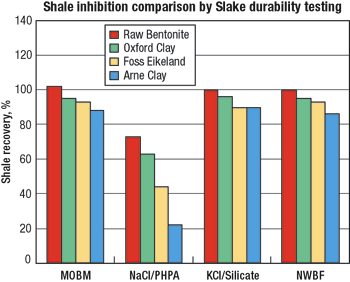 |
Fig. 1. The hydration suppressant collapses the clay’s hydrated structure and reduces water imbibitions, shown in this Slake durability test.
|
|
Research also identified a dispersion suppressant: an ampholytic, low-molecular-weight, water-soluble copolymer. It exhibits good biodegradability and low marine toxicity. The polymeric additive has a molecular weight and charge density that imparts encapsulation by limiting water penetration into the clays, Fig. 2. The molecular weight of the polymer allows flexibility in a wide range of mud densities and mud formulations. Its charge density provides improved clay surface binding of the polymer along with high-salinity and hardness tolerance. This compound has the ability to control both swelling and dispersion of water-sensitive clays without adverse rheological effects. The polymer also imparts some anti-accretion properties.
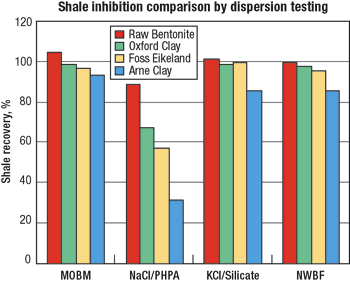 |
Fig. 2. The dispersion suppressant has a molecular weight and charge density that imparts encapsulation by limiting water penetration into the clays, shown by this Bar rolling test.
|
|
The third component, an accretion suppressant, is a unique blend of surfactants and lubricants that coats drill cuttings and metal surfaces. It reduces hydrated solids accretion on metals and reduces hydrated cuttings agglomeration, Fig. 3.
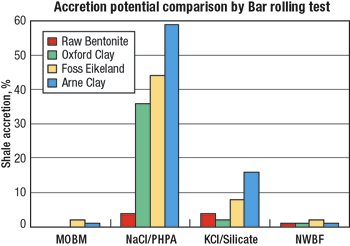 |
Fig. 3. An accretion suppressant prevents drill solids buildup below the bit, shown by this Bar rolling test.
|
|
This blended component exhibits stability in low- to high-salinity environments, is compatible with highly solids-laden (high-weight) muds, and has low marine toxicity. The suppressant helps prevent drill solids buildup below the bit, allowing cutters good contact with new formation for improved ROP. The component lowers the coefficient of friction, reducing torque and drag.
Xanthan gum was chosen as the rheology control agent for the mud, based on the high efficiency of the polymer and its tolerance to salinity and hardness. The presence of the hydration suppressant stabilizes the xanthan gum in solution, giving rheological control at temperatures up to 150°C (300°F). The polymer’s high, Low-Shear-Rate Viscosity (LSRV) and efficient carrying capacity allow optimized rheological control. This improves mud performance in extended reach and deepwater environments.
The final system component, a low-viscosity, highly modified, polysaccharide polymer was chosen as the optimal filtration-control agent. This polymer is stable in low-to-high salinities, and at high hardness levels. The low-viscosity contribution of the polymer allows control even at high-solids loading (high mud weights). The polymer interacts with the xanthan gum by polymeric substitution, providing improved LSRV for better hydraulics behavior, Fig. 4.
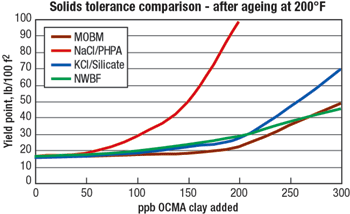 |
Fig. 4. A low-viscosity, polysaccharide polymer allows control even at high solids loading, shown by this solids tolerance test after ageing at 200°F.
|
|
Each component’s design and selection optimized synergies and improved overall system flexibility. The result is a novel, high-performance WBM, Table 1, that performs in a wide variety of base fluids over a wide density and temperature range and meets environmental requirements in most world areas.
| TABLE 1. Composition of NWBM used in laboratory |
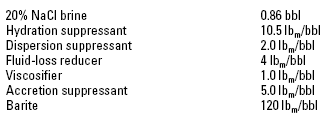 |
|
Testing was carried out on four outcrop shale substrates that were used in their native state:
- Raw bentonite – this Wyoming bentonite ore is predominantly sodium montmorillonite and has high swelling characteristics
- Foss Eikeland Shale – this Norwegian outcrop shale has about 15% sodium montmorillonite with high dispersion and accretion tendencies
- Oxford Clay – this UK outcrop shale has about 10% sodium montmorillonite with swell and disperse tendencies
- Arne Clay – this UK outcrop clay is predominantly kaolinite, is fragile, and has a very high disperse and accrete tendencies
Four drilling mud systems were compared:
- A MOBM with an oil-to-water (O/W) ratio of 80/20, Yield Point (YP) of 15, Equivalent Static Viscosity (ESV) of ~1,000 v and a density of 12 lb/gal.
- A NaCl/ PHPA WBM typically used in the US Gulf of Mexico, with 20% wt NaCl and 1 lb/bbl PHPA polymer. The YP was 15, weighted to 12 lb/gal with barite.
- A KCl/ silicate WBM that is one of the most inhibitive WBMs, with 10% KCl, and 8% sodium silicate. The YP was 15, weighted to 12 lb/gal with barite.
- A New Water-Based drilling Mud (NWBM) with a YP of 15, weighted to 12 lb/gal.
Based on these and many other test results, the NWBM was a significant improvement over existing WBMs from a laboratory standpoint and showed promise as a performance equivalent to invert emulsion drilling muds. The NWBM outperformed NaCl/ PHPA mud for shale inhibition, Fig. 5, and was an equivalent to KCl/ silicate and MOBM. The results for shale inhibition using dispersion testing showed results similar to Fig. 1. NWBM performance compares favorably with MOBM.
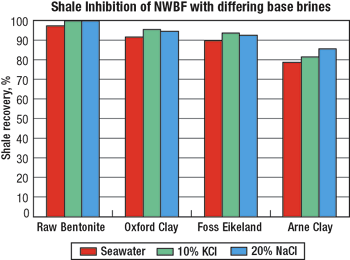 |
Fig. 5. Inhibition characteristics of the new water-based mud are shown using seawater, 10% KCl brine, and 20% NaCl brine. The muds had 3% hydration suppressant, 2-lb/bbl dispersion suppressant, and 1.5% accretion suppressant.
|
|
INITIAL FIELD TRIAL
The NWBM made its field trial debut in a Gulf of Mexico deepwater well in 3,797-ft water depth, where the high-inhibition characteristics were unique, Table 2. Inhibition testing on “gumbo” clays from the potential field trial area highlighted the performance potential of the NWBM.
| TABLE 2. Composition of NWBM used in the GoM field trial |
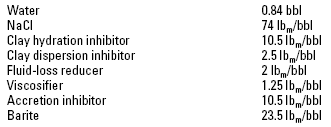 |
|
The new system was used to drill the 17-in. pilot hole and to open it to 22 in. from 6,125 ft to 7,360 ft. The interval is characterized by highly reactive shales and sand and is typically drilled with a 20% NaCl water-based mud containing PHPA. Previous offset wells encountered problems with shaker screen blinding, rapid depletion of the encapsulator and high dilution rates. Operators drilling similar sections in this area have overcome these problems using more expensive synthetic-based drilling muds.
One of the advantages of the NWBM system is mixing ease. The products can be added relatively quickly; two products are liquids, which saves time. To improve speed, a high-power hopper mixed the field-trial mud.
Prior to displacement, the shale shakers were dressed with 20/20-mesh screens on top and 84/84/84-mesh on bottom. Displacement was done at 800 gal/min. A 100-bbl viscosified seawater spacer and 50 bbl of a 10.8-lb/gal weighted viscous spacer were pumped in front of the 10-lb/gal NWBM. The interface was a clear cut, and no screen blinding occurred. The flowrate was immediately increased to 1,348 gal/min. The higher flowrate was handled by the five shakers without incident. On previous wells, the NaCl/ PHPA mud exhibited severe screen blinding, and the 84-mesh shaker screens had to be replaced with coarser 30-mesh screens.
After the cement plug was drilled (without mud treatment), the mud properties were not affected. Properties increased in pH to 10 from 9.5 and to 1,000 from 400 mg/L in hardness. The system is formulated bentonite-free and the dispersion suppressing polymer is calcium tolerant.
Rigsite test procedures were developed before the field trial to monitor product concentrations of the clay dispersion inhibitor and the clay hydration inhibitor. The tests ensured that optimized engineering control could be maintained over the system.
When drilling began, the cuttings at the shakers were dry, firm and very well encapsulated, indicating that the system provides inhibition. Another performance indication was the ability to pick up the drillstring without overpull and to resume drilling following a two-hour-plus survey, during which the drillpipe was not moved and circulation was interrupted. Dilution premix was continuously added to maintain the active volume along with the desired concentrations. The ROP averaged 150 ft/hr, but was as high as 300 ft/hr. On offset wells drilled with the 20% NaCl/ PHPA mud, the ROP averaged 95 ft/hr. This was a good test of the mud’s inhibitive character, which showed good cuttings integrity and encapsulation.
The interval was drilled to 7,366 ft using higher flowrates (1,350-1,400 gal/min). The mud properties remained very stable. It was necessary to add viscosifying polymer to the premix to maintain the rheology, as the mud would only incorporate a minimum amount of drill solids. After reaching 7,366-ft, a 100-bbl sweep was pumped and the mud was weighted up to 10.3 lb/gal. The bit and the bottomhole assembly were pulled out of hole completely free of gumbo shale, proving that the NWBM has a minimum accretion tendency.
Due to the excellent screenability observed during the 17-in. bit run, finer screens were run while opening the hole to 22 in. Two primary shakers were equipped with 140/110/110-mesh screens, and three were dressed with 110/110/110-mesh screens. This hole-opening section was equivalent to drilling a 14-in. section. The cuttings generated had the same integrity and were observed to be firmer and dryer than typical WBM cuttings. A steady rate of penetration averaging 120 ft/hr was maintained throughout the interval, and there were no problems with excessive cuttings. Dilution premix maintained volume and mud properties remained stable.
PROVEN SUCCESS
The NWBM has since been used on more than 300 wells around the globe. In more than 60% of the applications, the NWBM was used instead of IEM. It has also been used in a variety of situations, most notably:
- Deepwater record: 9,472-ft water depth, offshore Brazil
- Maximum mud weight: 17.2 lb/gal, Wyoming, US
- Maximum angle built: 90°, United Arab Emirates and Brazil
- Maximum number of intervals in one well: five (20-, 17-, 14-1/2 -, 12-1/4-.25-, 8.5-in.), Gulf of Mexico
- Longest interval: 9,384 ft, onshore S. China
- Largest directional interval: 8,900 ft, 171D2 in., 65° angle, North Sea.
Benchmarks against MOBM, synthetic IEM and other WBM have been conduced evaluating the performance of the NWBM in the field. In every instance, the NWBM far exceeded the performance of other WBMs for improved wellbore stability, improved drilling performance (ROP), ease of mud properties maintenance, dilution rates and drilling economics.
In many cases, the NWBM shows equivalent drilling performance to IEM for wellbore stability and drilling rates. Enhanced shale inhibition and low accretion risk have allowed the use of high-performance PDC drill bits for optimal drilling rates even through some extremely reactive shale formations.
The NWBM is characterized by large, well-defined, cuttings that are readily removed by the primary solids-control equipment on the first pass, ensuring that the mud does not become rapidly contaminated by drill solids and that dilution rates to maintain drilling mud parameters are low.
Field usage has proven that the NWBM can be easily prepared, has good screenability through fine shaker screens and has outstanding drilling performance, approaching that of an IEM. 
|
THE AUTHORS
|
 |
Steve Young is global technology advisor for M-I Swaco. Young has 18 years of experience in drilling fluids in both operational and technical positions. His position identifies new technology requirements, translates them into R&D projects and transfers R&D results to field-usable technologies. Young earned a BSc in Pharmacy from RGU in Aberdeen, Scotland.
|
|
 |
Gamal Ramses is technical services manager at M-I Swaco, covering the Middle East and North Africa region. He has 26 years of experience in drilling, reservoir and completions fluids. Ramses earned a BSc degree in Chemical Engineering from Cairo University, Egypt.
|
|
|











